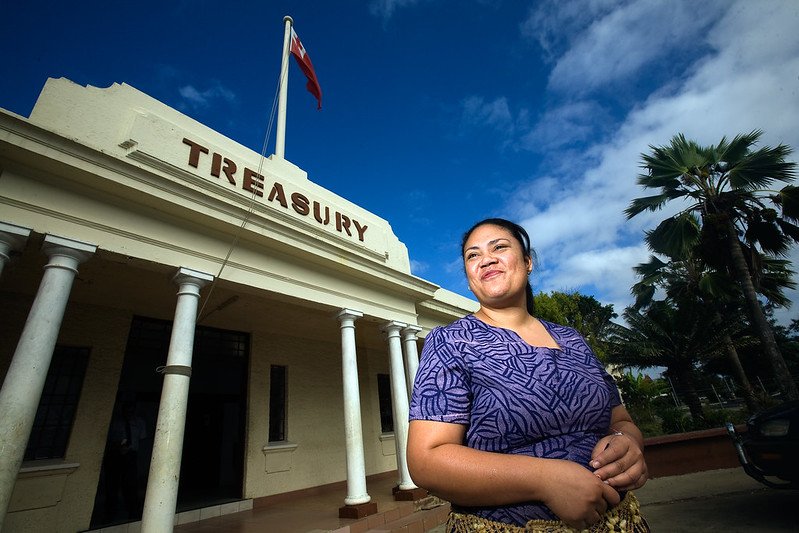INVESTING IN SOCIAL PROTECTION: FINANCING PATHWAYS FOR THE PACIFIC AND TIMOR-LESTE
Investing in social protection: Financing pathways for the Pacific and Timor-Leste
By Charles Knox-Vydmanov
Social assistance expenditure in the Pacific and Timor-Leste has grown substantially over the last decade. Yet there remain significant gaps in the coverage and adequacy of social protection systems. Coverage of some groups—such as families with children—remains particularly low. Meanwhile, countries such as Papua New Guinea, Solomon Islands and Vanuatu have no government-run social protection systems.
Research by the Australian Government’s Partnerships for Social Protection program explores how Pacific governments can fund further investments in social protection. Investing in social protection in good times and bad: An assessment of social protection financing looked at the current and historical levels of expenditure in 14 countries across the region, helping identify future investment strategies.
Social protection is increasingly recognised as helping underpin economic development—a key focus for the Pacific region as it continues recovering from COVID-19 and other shocks. Government-funded social assistance—a type of social protection that doesn’t rely on individual contributions—protects vulnerable groups including older persons, persons with disabilities and families with children. It is increasingly used to respond to shocks including COVID-19, natural disasters and inflationary spikes. While the benefits of social protection are clear, the pathways for increasing investment are more complex.
Many countries across the Pacific face a challenging fiscal outlook. Significant fiscal response packages combined with lower levels of government revenue during the height of the COVID-19 crisis, mean that most countries experienced significant fiscal deficits resulting in higher levels of government debt. While most economies are recovering, the region’s growth outlook is relatively weak. This limits how much revenue governments can generate to address debt issues or allocate to new investments.
Whether countries can secure fiscal space for social protection depends on accessing different revenue sources, which vary from country to country. The countries in the strongest position are those with large sovereign rents, enabling them to better manage the COVID-19 crisis. Others will likely have to rely on increases in tax revenue.
The World Bank and International Monetary Fund (IMF) have outlined various policy and administrative approaches available to raise tax revenues. For example, the IMF estimates that Pacific island countries (PIC) could potentially collect “an additional 3 percent of tax revenue to GDP in the short to medium term” through measures such as implementing value added taxes, adjusting personal income taxes, and removing existing tax exemptions for foreign and domestic investors. However, the political economy of such reforms can be challenging, and much of this revenue is expected to be allocated to fiscal consolidation (reducing government deficits). Efficiency gains through reallocation from other sectors is an option but can be politically complex.
Official development assistance (ODA) is another potential source of revenue to finance social protection. The Pacific is the most aid dependent region in the world, and recent years have seen increasing ODA allocations tied to social protection, particularly in the context of COVID-19. ODA is valuable in supporting countries to strengthen social protection systems and finance shock responses. However, securing financing commitments to fund benefits can be challenging, as donors are rarely able to commit to long-term support. Nevertheless, long-term or indefinite budget support could provide a sustainable mechanism for maintaining ongoing social protection benefits.
While most countries have some scope to generate fiscal space, the outlook is uncertain, and the scale will be modest in many cases. Importantly, any additional funds will need to be shared with other priority investments, including other social sectors such as health and education. A pragmatic approach will be to gradually increase investment in social protection, according to the evolution of the wider fiscal situation.
Although modest, experience shows this incremental approach can significantly reshape social protection in a relatively short period. For example, Fiji has increased its investment in social assistance from 0.4 to 1.4 per cent of gross national income (GNI) since 2013, mostly through modest year-on-year changes. While such processes tend to happen on an ad hoc basis, through annual budget negotiation, this can be factored into medium-term expenditure planning. For example, Tonga—who is seeking to decrease the age of its universal pension (currently age 70)—recently set out an incremental process to expand coverage in its latest budget statement. This involves decreasing the eligibility age to 67 in FY2025, 65 in FY2026 and 63 in FY2027.
PICs have, in fact, been some of the most innovative countries globally in finding ways to gradually expand social protection schemes while adapting to the fiscal environment. Common approaches have included gradually expanding the ages of eligibility, differentiating benefits by severity of disability and age, and gradually boosting benefit adequacy over time.
While there are never easy answers in financing social protection, most countries likely have scope to continue strengthening their social protection systems. This depends on factors such as the pace of economic recovery and efforts to generate additional government revenues. Governments can prepare for these processes by setting out pathways to incrementally expand social protection that can be adjusted based on the evolving economic and fiscal context in the coming years. Fortunately, the historical development of social protection provides ample experience of how this can be done.
Related publications:



